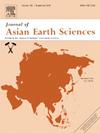Orogenic segmentation across central and eastern Himalaya: Insights from source parameters derived from local earthquakes
IF 2.7
3区 地球科学
Q2 GEOSCIENCES, MULTIDISCIPLINARY
引用次数: 0
Abstract
Orogenic segmentation across the arcuate Himalayan belt complicates deformational trends beyond central Nepal. Here, we attempt to discern the implications of spatially varying deformation on seismic hazard potential in eastern Nepal, Sikkim and Bhutan Himalayas. A comprehensive catalogue of 2,018 local earthquakes recorded during past deployments is utilized to estimate source parameters from P and S wave spectra. Results indicate stress drop (Δσ) and moment magnitude exhibit scaled dependence with linearly increasing relation. Scaling traced between seismic moment and corner frequency ( \protect \relax \special {t4ht=−}3) indicates no breakdown of earthquake scaling law for small earthquakes, thus holding potential to be scaled for modelling large earthquakes in the region. Empirical relationships established (=0.55+1.43, =0.68 ()-6.20; =0.61+1.33, =0.66 ()-6.06; and =0.66+1.37, =0.66 ()-5.94) can serve as input for seismic hazard assessment in eastern Nepal, Sikkim and Bhutan. Spatial variability of Δσ is reflective of high coupling along the Main Himalayan Thrust (MHT), high strain rate and lower seismic activity in eastern Nepal and Bhutan. Strike-slip faulting in Bhutan (along DCFZ and KFZ) releases higher Δσ (7–15 MPa) as compared to thrusting in Nepal releasing lower Δσ (2 MPa). Low coupling along MHT in Sikkim substantiated by frequent release of stress through high seismic activity impedes low Δσ (2 MPa). Beneath MHT, high radiated energy estimates (9 Nm) evidenced a high degree of heterogeneity except for eastern Nepal (8 Nm). Thus, eastern Nepal and Bhutan have potential to experience great earthquake, while Sikkim is susceptible to hazard due to active deformation along a multi-fault system. Consensus of spatial variation of source parameters with interseismic coupling, strain rate and deformation mechanism indicates orogenic segmentation has crucial implications on seismic hazard potential.

求助全文
约1分钟内获得全文
求助全文
来源期刊

Journal of Asian Earth Sciences
地学-地球科学综合
CiteScore
5.90
自引率
10.00%
发文量
324
审稿时长
71 days
期刊介绍:
Journal of Asian Earth Sciences has an open access mirror journal Journal of Asian Earth Sciences: X, sharing the same aims and scope, editorial team, submission system and rigorous peer review.
The Journal of Asian Earth Sciences is an international interdisciplinary journal devoted to all aspects of research related to the solid Earth Sciences of Asia. The Journal publishes high quality, peer-reviewed scientific papers on the regional geology, tectonics, geochemistry and geophysics of Asia. It will be devoted primarily to research papers but short communications relating to new developments of broad interest, reviews and book reviews will also be included. Papers must have international appeal and should present work of more than local significance.
The scope includes deep processes of the Asian continent and its adjacent oceans; seismology and earthquakes; orogeny, magmatism, metamorphism and volcanism; growth, deformation and destruction of the Asian crust; crust-mantle interaction; evolution of life (early life, biostratigraphy, biogeography and mass-extinction); fluids, fluxes and reservoirs of mineral and energy resources; surface processes (weathering, erosion, transport and deposition of sediments) and resulting geomorphology; and the response of the Earth to global climate change as viewed within the Asian continent and surrounding oceans.
 求助内容:
求助内容: 应助结果提醒方式:
应助结果提醒方式:


